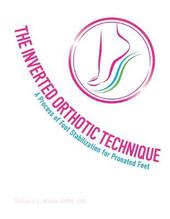
|
The Inverted Orthotic Technique: A Process of Foot Stabilization for Pronated Feet
Paperback / softback
Main Details
| Title |
The Inverted Orthotic Technique: A Process of Foot Stabilization for Pronated Feet
|
| Authors and Contributors |
By (author) Richard Blake
|
| Physical Properties |
| Format:Paperback / softback | | Pages:158 | | Dimensions(mm): Height 279,Width 215 |
|
| ISBN/Barcode |
9781543981612
|
| Audience | |
|---|
|
Publishing Details |
| Publisher |
BookBaby
|
| Imprint |
BookBaby
|
| Publication Date |
14 October 2019 |
| Publication Country |
United States
|
Description
The Inverted Orthotic Technique is a book about lower extremity biomechanics as practiced by Richard L Blake, DPM at the Orthopedic Sports Institute in Saint Francis Memorial Hospital San Francisco, California. Dr. Blake has been a practicing podiatrist for 40 years and works in a multi-disciplinary practice. Dr. Blake has written and lectured both nationally and internationally on biomechanics and sports medicine topics. The Inverted Orthotic Technique has been studied for over 30 years and utilized throughout the world. Dr. Blake hopes this book will help his readers be up to date on all the changes in the technique over these last 30 years since he first started lecturing. The Inverted Orthotic Technique is a book on making patients more stable. It is utilized along with proper shoes, strengthening exercises, appropriate stretching exercises, and training techniques. It is part of a process with many adjustments, modifications, and timing issues. Dr. Blake looks at the Inverted Orthotic Technique as a tool to help stability and injuries, but a tool that is fairly fluid. The Inverted Orthotic Technique has a certain arch shape, and several methods to decide on the amount of correction to utilize. Asymmetrical corrections are a vital part of this technique as most patients have different feet, sometimes by a large amount. Even though the Inverted Orthotic Technique is looked on as a Medial support, the book heavily goes through the techniques to stabilize the lateral column. Dr. Blake has worked with many laboratories interested in learning the device and still does.One half of the book goes over the entire process of the Inverted Orthotic Technique and the second half of the book (Appendices) reviews very important aspects of lower extremity biomechanics. These include: symptoms related to pronation, symptoms related to supination, 12 point biomechanical outline, gait evaluation, biomechanical examination techniques, methods for pronation control, role of weak and tight muscles, the podiatric laboratory cast correction variables in use presently, impression casting, and references for the Inverted Orthotic Technique. There is a Pre-Test with answers, and through out the book there are almost 100 self test questions with answers. The practitioner should be able to understand the role of the Inverted Orthotic Technique by the end of the book.
Author Biography
Dr. Richard Blake is a practicing Podiatrist in San Francisco, California. He invented the Inverted Orthotic Technique and has spent over 35 years studying its affects on his patients. He has lectured nationally and internationally on the device also called the Blake Inverted Orthosis. He practices biomechanics and sports medicine at the famed Orthopedic Sports Institute at Saint Francis Memorial Hospital in San Francisco for 38 years. He is the past president of the American Academy of Podiatric Sports Medicine. He has published over 50 articles on sports medicine and biomechanics. He has taught for over 20 years at the California College of Podiatric Medicine, now the California School of Podiatric Medicine at Samuel Merritt University in Oakland, California. He is the author of a blog on foot injuries called drblakeshealingsole. He has been a marathon runner and avid basketball player. He is now focusing on hiking with an upcoming adventure on the famous Camino de Santiago in Spain. Dr. Blake's 3 true loves are his family first, his profession of podiatry, and teaching. He loves teaching through patient care, with students, his blog, and this book is an extension of that love affair of podiatry and teaching. He feels very blessed to have found his chosen profession dedicated to the care of patients. His hope is that this book helps the podiatry profession is some small way.
|